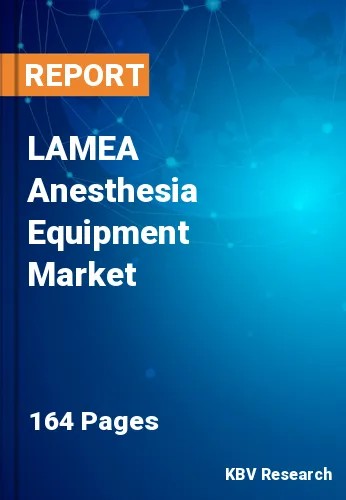The Latin America, Middle East and Africa Anesthesia Equipment Market would witness market growth of 11.0% CAGR during the forecast period (2023-2030).
In the market for anesthesia equipment, the adoption of computer-controlled anesthesia machines is a new development. Computer-controlled anesthetic machines aid in minimizing the patient's discomfort throughout surgical procedures and offer features such as alerts to alert in the event of an emergency or backup needed to switch the defective pipeline or cylinder. The ability to undertake a wider variety of surgeries has been enabled by improvements in surgical methods. The use of surgical therapies has been facilitated by minimally invasive procedures, robotic-assisted operations, and other cutting-edge methods.
Chronic diseases, including hypertension, diabetes, and respiratory conditions, are rising due to changing lifestyles, especially sedentary behaviors, poor diets, and elevated stress levels. To monitor and treat these problems, surgical treatments are frequently required. The need would eventually increase due to all of this. Anesthesia devices were used more frequently due to the sharp increase in sports-related SCI and accidental fracture cases requiring surgical treatments.
Saudi Arabia largely finances healthcare spending in the Gulf Cooperation Council (GCC), and the Saudi government continues to place a high premium on the industry. Healthcare & social development will account for $36.8 billion in 2022, or 14.4% of its total budget. 9.1% of Brazil's GDP is allocated to healthcare. 63% of the 6,642 hospitals in Brazil are private. 532,645 hospital beds, 88,000 healthcare support services, 502,000 doctors, 331,000 dentists, and 89,000 pharmacies are all present as of 2021. Since anesthetic equipment is among the essential requirements for many medical operations, the region's thriving medical industry is projected to offer growth chances for market.
The Brazil market dominated the LAMEA Anesthesia Equipment Market by Country in 2022 and would continue to be a dominant market till 2030; thereby, achieving a market value of $610.2 million by 2030. The Argentina market is showcasing a CAGR of 11.6% during (2023 - 2030). Additionally, The UAE market would register a CAGR of 10.7% during (2023 - 2030).
Based on Type, the market is segmented into Anesthesia Devices (Anesthesia Workstation, Anesthesia Delivery Machines, Anesthesia Ventilators, Anesthesia Monitors and Others) and Anesthesia Disposables (Anesthesia Circuits (Breathing Circuits), Anesthesia Masks, Endotracheal Tubes (ETTS), Laryngeal Mask Airways (LMAS) and Others). Based on Vertical, the market is segmented into Orthopedics, Neurology, Cardiology, Respiratory Care, Urology, General Surgery, Dental, Ophthalmology and Others. Based on End User, the market is segmented into Hospitals, Clinics, Ambulatory Surgical Centers and Others. Based on countries, the market is segmented into Brazil, Argentina, UAE, Saudi Arabia, South Africa, Nigeria, and Rest of LAMEA.
Free Valuable Insights: The Worldwide Anesthesia Equipment Market is Projected to reach USD 32.2 Billion by 2030, at a CAGR of 9.2%
The market research report covers the analysis of key stake holders of the market. Key companies profiled in the report include Medtronic PLC, GE HealthCare Technologies, Inc., Koninklijke Philips N.V., Dragerwerk AG & Co. KGaA, Getinge AB, Ambu A/S, SunMed, LLC, Medline Industries, Inc., Penlon Ltd. (BPL Medical Technologies) and Heyer Medical AG (AEONMED Group).
By Type
By Application
By End User
By Country
Our team of dedicated experts can provide you with attractive expansion opportunities for your business.

